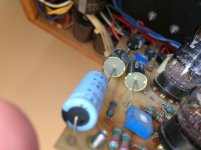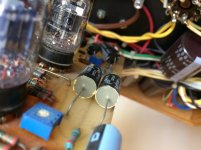Hello Everyone,
I'm looking for advice on my first attempt at amp repair. I own a Music Reference RM-9 MKII that's been sounding a bit muddy lately. Most recently the left channel cut out entirely. I popped the hood to find that all four coupling capacitors (Solen PPE 0.22uf 630v) are leaking. I've ordered 10 so that I can match and replace these caps, but was wondering if there is anything else that I should be looking for. I've also heard of people using a variac to slowly bring an amp up to full voltage after a repair attempt. Is this something that I should be doing? Any advice for a first timer would be greatly appreciated.
I'm looking for advice on my first attempt at amp repair. I own a Music Reference RM-9 MKII that's been sounding a bit muddy lately. Most recently the left channel cut out entirely. I popped the hood to find that all four coupling capacitors (Solen PPE 0.22uf 630v) are leaking. I've ordered 10 so that I can match and replace these caps, but was wondering if there is anything else that I should be looking for. I've also heard of people using a variac to slowly bring an amp up to full voltage after a repair attempt. Is this something that I should be doing? Any advice for a first timer would be greatly appreciated.
It's very unlikely that the metalized polypropylene film Solen PPE capacitors are leaking,
since there's nothing inside to leak. Maybe they are just glued down to the board.
More likely to degrade the sound after 25 years are the tubes and the power supply electrolytic capacitors.
You could first replace the tubes, and see if the sound improves enough to delay replacing the electrolytics.
If do you end up replacing the electrolytics, a Variac is good tool to have. They also appear to be hot-glued down.
since there's nothing inside to leak. Maybe they are just glued down to the board.
More likely to degrade the sound after 25 years are the tubes and the power supply electrolytic capacitors.
You could first replace the tubes, and see if the sound improves enough to delay replacing the electrolytics.
If do you end up replacing the electrolytics, a Variac is good tool to have. They also appear to be hot-glued down.
Last edited:
To add to what Ray has said, if you had an electrically leaky coupling cap, you would likely also find that one or more of your output tubes glowing bright red.
You might want to post a photo here of what you see around the Solen caps.
You might want to post a photo here of what you see around the Solen caps.
Start by DeOxit'ing all the contacts, then check all the voltages, then the bias, if you know how to; beware there's 400+ Volts in there.
if you had an electrically leaky coupling cap, you would likely also find that one or more
of your output tubes glowing bright red.
Not for long!
Thanks for all of the quick responses! I've attached a pic of the caps in question. And I'd really appreciate a copy of the service manual. I've put together a Dynaco ST-35, and am comfortable with the high voltages, but need to do some reading before I could check voltages around the amp. (I'd have a tech look at it, but there's that thing going around and I've always dreamed about being able to service my own amp so now seemed like the time.)
Attachments
No idea what that is, maybe glue under the label has melted from the heat.
Someone else may have experience with this problem. Since you've ordered the replacements,
might as well do it.
Someone else may have experience with this problem. Since you've ordered the replacements,
might as well do it.
I have a couple of drawers full of unused Solen capacitors and none look like that. Maybe the heat like Rayma said.
Craig
Craig
After you remove them, pull off the label and post a photo of what's under the label.
I've never seen this happen with a film capacitor before.
I've never seen this happen with a film capacitor before.
Electrolytics look fine to the eye. The input tubes are old, but look in decent condition. Would a bad input tube just cause a channel to cut out all of a sudden? Is there anything else I should look into before I drop the coin on a new quad of 6922s?
That is the adhesive under the label moving around. You can measure the DC voltage on either side of each cap. One side should show some high positive voltage and the other side will either show 0V or some negative voltage. This is sufficient to test for cap leakage.
I would not replace those caps unless they actually measure badly. You may introduce new problems that you have to debug later.
I would not replace those caps unless they actually measure badly. You may introduce new problems that you have to debug later.
Usually this is not the failure mode for something like a 6922.Electrolytics look fine to the eye. The input tubes are old, but look in decent condition. Would a bad input tube just cause a channel to cut out all of a sudden?
Yeah, I wouldn't replace the tubes just yet.Is there anything else I should look into before I drop the coin on a new quad of 6922s?
You have an amplifier with two channels. Make a little table and list all the pins on all the tubes, then measure all the DC voltages that you get with the amp running.
A bad 6922 will show a really high voltage on a given plate and a low voltage on the corresponding cathode. That would be a low voltage at pin 3 and a high voltage at pin 1, for example. Weird voltages don't always mean a tube is bad, but they can at least help you focus on what's going on.
- Home
- Amplifiers
- Tubes / Valves
- Music Reference RM-9 MKII - Repair Advice

